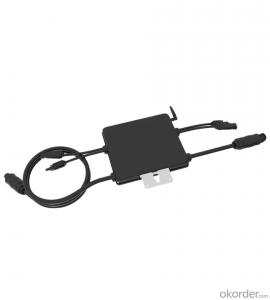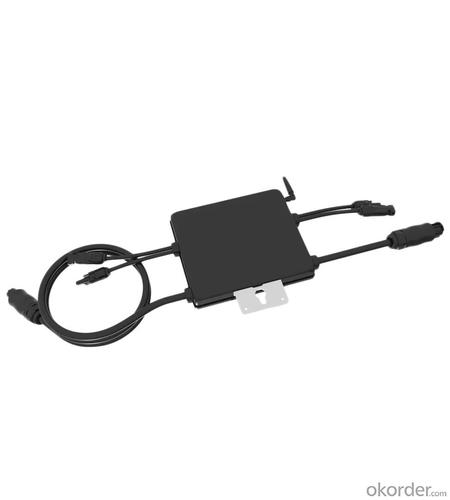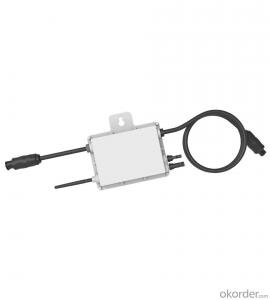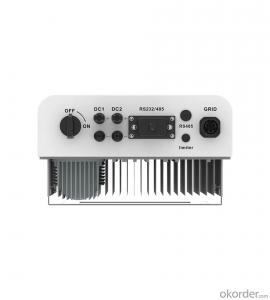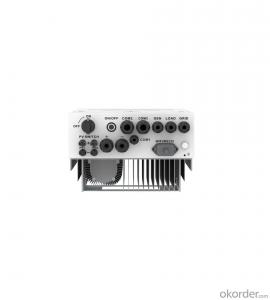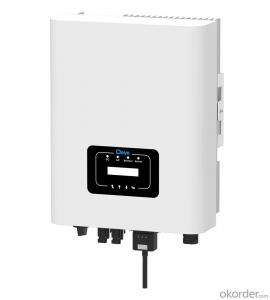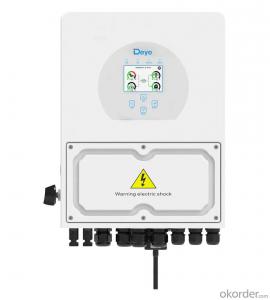Gan Solar Inverter Sun500g/600g | 500-600w | Single Phase | 2 MPPT | Micro-Inverter | Rapid Shutdown
- Loading Port:
- Ningbo
- Payment Terms:
- TT OR LC
- Min Order Qty:
- 100 pc
- Supply Capability:
- 5000 pc/month
OKorder Service Pledge
OKorder Financial Service
You Might Also Like
Specification
The series microinverter features low startup voltage of 20V and Max. DC input volage of 60V. Module-level monitoring providing each panel’s performance data, faster O&M. With built-in WIFI module, easier installation and commissioning for installer. Also, it supports various output voltage and frequency, 127/208/240V@60Hz, 230V/50Hz.
Rapid shutdown function
IP67 protection degree,10 years warranty
PLC, Zigbee or WIFI communication
2 MPP trackers, module level monitoring
Cooling glue filling, good thermal performance
Suitable for Europe, North America, South America and other regions
| Model | SUN500G-230-EU | SUN600G2-US-208/240 | SUN600G2-US-220 | SUN600G2-US-127 |
| Input Data (DC) | ||||
| Recommended input Power (STC) | 210~400W (2 Pieces) | 210~400W (2 Pieces) | 210~400W (2 Pieces) | 210~350W |
| Maximum input DC Voltage | 60V | |||
| MPPT Voltage Range | 25~55V | |||
| Operating DC Voltage Range | 20~60V | |||
| Max. DC Short Circuit Current | 13A | |||
| Max. input Current | 10.4A×2 | |||
| Output Data (AC) | ||||
| Rated output Power | 600W | 600W | 600W | 500W |
| Maximum output Power | 600W | 600W | 600W | 500W |
| Maximum output Current | 2.2A | 2.9A / 2.5A | 2.7A | 4A |
| Nominal Voltage / Range | 184~265V | 208V / 183~229V 240V / 211~264V | 220V/176~242V | a.c.95~155V @127Vac |
| Nominal Frequency / Range | 50.0 / 47.5~51.5Hz | 60.0 / 59.3~60.5Hz | 60.0 / 59.3~60.5Hz | 60.0 / 59.3~60.5Hz |
| Extended Frequency / Range | 50.0 / 45~55Hz | 60.0 / 55~65Hz | 60.0 / 55~65Hz | 60.0 / 55~65Hz |
| Power Factor | >0.99 | |||
| Maximum units per branch | 11 8 / 10 9 6 | |||
| Efficiency | ||||
| CEC Weighted Efficiency | 95% | |||
| Peak Inverter Efficiency | 96.5% | |||
| Static MPPT Efficiency | 99% | |||
| Night Time Power Consumption | 50mW | |||
| Mechanical Data | ||||
| Ambient Temperature Range | -40~65℃ | |||
| Size (mm) | 185W×161H×29D (Without mounting bracket and cable) | |||
| Weight (kg) | 2.4 | |||
| Cooling | Natural cooling | |||
| Enclosure Environmental Rating | IP67 | |||
| Features | ||||
| Compatibility | Compatible with 60~72 cell PV modules | |||
| Communication | Power line / WIFI / Zigbee | |||
| Compliance | UL1741、VDE0126、VDE4105、IEC62109、CE、INMETRO | |||
| Warranty | 10 years | |||
- Q: How does a solar inverter handle power quality disturbances?
- A solar inverter handles power quality disturbances by monitoring the incoming power from the solar panels and adjusting its output accordingly. It uses various control mechanisms to regulate voltage and frequency, ensuring that the power generated by the solar panels is synchronized with the grid. This helps in maintaining a stable and high-quality power supply, minimizing the impact of disturbances such as voltage fluctuations or frequency variations. Additionally, some advanced solar inverters also offer features like grid support functions and reactive power compensation to further enhance power quality.
- Q: What is the maximum number of MPPT inputs in a solar inverter?
- The maximum number of MPPT inputs in a solar inverter can vary depending on the specific model and brand. However, in general, solar inverters can have anywhere from one to multiple MPPT inputs, with some high-end models offering up to six or more MPPT inputs.
- Q: Can a solar inverter be upgraded or expanded?
- Yes, a solar inverter can be upgraded or expanded. Upgrades may involve adding new features or improving the efficiency of the existing inverter. Expansion typically refers to increasing the capacity of the inverter to accommodate additional solar panels. However, the extent to which an inverter can be upgraded or expanded varies depending on the specific model and manufacturer.
- Q: What is the role of a solar inverter in preventing system downtime?
- The role of a solar inverter in preventing system downtime is to efficiently convert the DC power generated by solar panels into AC power that can be used by electrical devices. It ensures the smooth operation of the solar power system by regulating the flow of electricity, monitoring voltage levels, and protecting against potential issues such as overloading or short circuits. By maintaining a stable and reliable power supply, the solar inverter plays a crucial role in minimizing system failures and downtime.
- Q: How does a solar inverter handle voltage sags or swells in the grid?
- A solar inverter handles voltage sags or swells in the grid by constantly monitoring the grid voltage. When it detects a voltage sag (drop below a certain threshold) or swell (increase above a certain threshold), it adjusts its output accordingly. In the case of a sag, the inverter boosts its output voltage to compensate for the drop in grid voltage. Conversely, in the case of a swell, the inverter reduces its output voltage to prevent any damage to connected devices. This ensures that the solar inverter maintains a stable and consistent voltage supply to the connected load, regardless of fluctuations in the grid voltage.
- Q: How long does a solar inverter last?
- A solar inverter typically has a lifespan of around 10 to 15 years, although this can vary depending on various factors such as the quality of the inverter, its usage, and maintenance.
- Q: What is the role of a solar inverter in a net metering system?
- The role of a solar inverter in a net metering system is to convert the direct current (DC) produced by the solar panels into alternating current (AC) that can be used to power appliances in a home or business. It also ensures that any excess electricity generated by the solar panels is fed back into the grid, allowing the user to earn credits or be compensated for the excess energy.
- Q: What is the role of power ramp rate control in a solar inverter?
- The role of power ramp rate control in a solar inverter is to regulate the rate at which the power output of the solar system increases or decreases. This control is important to ensure the stability and reliability of the grid, as sudden changes in power generation can cause disruptions. By gradually ramping up or down the power output, the solar inverter can respond to grid conditions and prevent overloading or underutilization of the system, ultimately improving the overall performance and efficiency of the solar installation.
- Q: How does a solar inverter handle voltage fluctuations in the grid?
- A solar inverter handles voltage fluctuations in the grid by continuously monitoring the grid voltage. When the voltage exceeds or drops below the acceptable range, the inverter adjusts the power output of the solar panels accordingly. It stabilizes the voltage by regulating the flow of electricity from the solar panels, ensuring a consistent and safe supply of power to the grid.
- Q: Can a solar inverter be used in a solar-powered electric vehicle charging station?
- Yes, a solar inverter can be used in a solar-powered electric vehicle charging station. A solar inverter is responsible for converting the direct current (DC) generated by solar panels into alternating current (AC) which is suitable for use in electric vehicles. Therefore, it plays a crucial role in converting the solar energy into electricity that can be used to charge electric vehicles at the charging station.
Send your message to us
Gan Solar Inverter Sun500g/600g | 500-600w | Single Phase | 2 MPPT | Micro-Inverter | Rapid Shutdown
- Loading Port:
- Ningbo
- Payment Terms:
- TT OR LC
- Min Order Qty:
- 100 pc
- Supply Capability:
- 5000 pc/month
OKorder Service Pledge
OKorder Financial Service
Similar products
Hot products
Hot Searches
Related keywords
